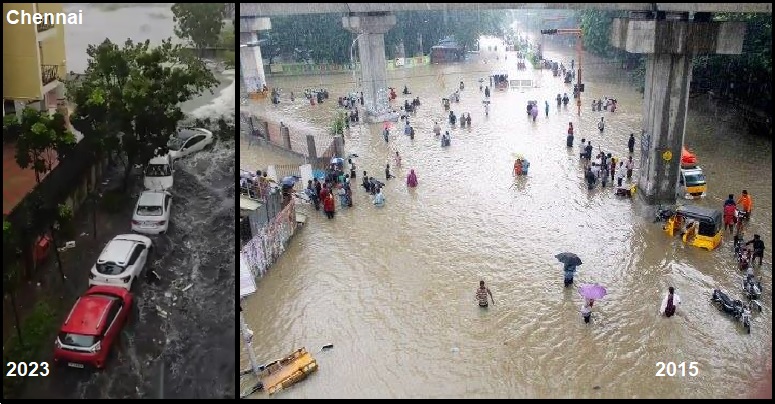
Gangtok, 7 Dec : The recent heavy rainfall and flooding in Chennai, triggered by Cyclone Michaung, has once again underscored the vulnerability of Indian cities to climate-induced disasters. Within a span of 48 hours by December 4, 2023, the city witnessed over 40 cm of rainfall, resulting in severe inundation and emphasizing the escalating climate crisis faced by urban India.
While the devastation in Chennai was exacerbated by the cyclone, it’s crucial to recognize that this is not solely responsible for the scale of destruction. Chennai has a history of flooding, notably in 2015 during a historic flood caused by heavy northeast monsoon rainfall. This earlier event served as a wake-up call, exposing the repercussions of insufficient urban planning and institutional capacity.
The factors contributing to such flooding are diverse, encompassing heavy rainfall, inadequate drainage systems, and the inability of rivers to manage high discharge levels. Urbanization exacerbates the situation, with encroachments on water bodies and ecologically sensitive zones further compounding the problem. The flat terrain in Chennai adds to the complexity, hindering efficient water drainage.
The challenges faced by Chennai are not isolated; they reflect a broader narrative of climate vulnerability across Indian cities. Metropolitan areas like Kolkata and Mumbai confront substantial risks from sea-level rise, tropical cyclones, and riverine flooding. These densely populated cities are already experiencing the impacts of climate change, including intensified rainfall, flooding, and heightened drought risks.
Research commissioned by the World Bank Group warns that India, being close to the Equator, will experience higher sea-level rises than higher latitudes. This poses a severe threat to coastal cities, leading to saltwater intrusion, agricultural impacts, groundwater quality degradation, and potential increases in waterborne diseases.
The Intergovernmental Panel on Climate Change (IPCC) report in 2021 sounded a dire warning for India, predicting that a dozen cities, including Mumbai, Chennai, Kochi, and Visakhapatnam, could be submerged by nearly three feet of water by the end of the century.
The risks are not merely theoretical; over seven million coastal farming and fishing families are already feeling the effects. Coastal erosion, exacerbated by rising seas, threatens the loss of about 1,500 square kilometers of land by 2050, impacting valuable agricultural areas and the existence of coastal communities.
Indian coastal zones, especially low-lying coastal areas and river deltas, are highly susceptible to increased flooding. Metropolitan areas like Mumbai, Kolkata, and Chennai face a heightened risk of more frequent and severe floods, potentially displacing millions and affecting livelihoods and infrastructure.
However, the threat of flooding due to climate change isn’t confined to coastal cities; inland areas are equally susceptible. Cities in Bihar, Himachal Pradesh, Sikkim, and Uttarakhand have experienced monsoon-triggered flooding and landslides. Even the capital, Delhi, faced heavy flooding earlier in the year.
In Sikkim, a Glacial Lake Outburst (GLOF) on October 4, 2023, resulted in significant loss of lives and property. The Teesta flood, fueled by the outburst, severely damaged the National Highway NH10, a major lifeline for the mountainous state. The gradual melting of glaciers, a consequence of the Earth’s rising temperature driven by industrialization and urbanization, is emerging as a ticking time bomb with the potential to unleash more significant and more catastrophic events than initially estimated.
The slow but steady retreat of glaciers is a visible manifestation of the impact of human activities on the planet. The increase in Earth’s temperature, fueled by industrial processes and the rapid growth of urban areas, has set in motion a process that carries far-reaching consequences.
The changing pattern of extreme weather events is evident, with flood-prone areas becoming drought-prone and vice versa, affecting over 40% of Indian districts. Unplanned urban construction in fragile settings is blamed for a significant part of the destruction in hill states.
Responding to these challenges requires a multifaceted approach. Strict enforcement of building codes, anticipation of climate-related disasters in urban planning, and protection against sea-level rise through coastal embankments and Coastal Regulation Zone codes are essential. Additionally, adopting watershed management and the ‘sponge city’ concept can mitigate flood risks.
Indian policymakers are not oblivious to these threats. Initiatives like the Mumbai Climate Action Plan (MCAP) 2022 aim to enhance climate resilience through evidence-based planning. Improvements in hydro-meteorological systems and the installation of flood warning systems can aid citizens in preparing for and responding to impending disasters.
Despite these efforts, the challenge remains daunting. Climate change is intensifying the natural water cycle, bringing more intense rainfall, flooding, and drought. Indian cities must adapt by integrating climate risk into their development plans and actions.
The recent flooding in Chennai serves as a stark reminder and a call to action to build cities capable of withstanding the unpredictable and severe impacts of a changing climate. As Indian cities continue to grow, the urgency for resilient infrastructure and sustainable urban planning has never been greater.





